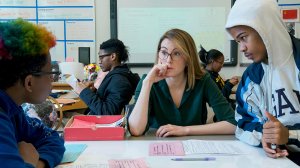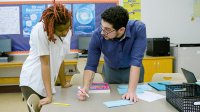Blended Learning Built on Teacher Expertise
An inside look at a teacher-designed instructional model that combines blended learning, student self-pacing, and mastery-based grading.
Chaos is one of the most amazing and challenging aspects of the teaching profession. No matter how hard you plan, your students walk into your classroom every day with different backgrounds, skills, and states of mind, and you have to roll with that.
For most educators across the country, nothing is more challenging than effectively differentiating for all learners—it’s a cardinal principle of effective instruction that is extremely difficult to execute well. When we use traditional lectures with a fixed pacing guide, meeting the unique needs of all students can feel like an unconquerable task.
When I used to lecture in my International Baccalaureate Math class at Eastern Senior High School in Washington, DC, the bulk of my students were either bored or lost, and I had no choice but to teach to the middle. Each day, I would invest time and energy in planning and putting on a performance to engage my students, only to find that just a few truly listened. My students were not mastering content, and day in and day out I felt like a failure.
Devising a New Teaching Model
In an effort to redesign my classroom around my students’ diverse needs, I developed a scalable instructional model built around three core principles.
1. Blended instruction: Most blended learning models involve outsourcing the creation of digital content. In the model I developed and then shared with other teachers at my school, students access content through instructional videos and other online resources created by their teacher.
This creates a learning environment where traditional lectures are eliminated and students have unrestricted access to content: “The video instruction makes me feel like I’ve been able to clone myself,” says my colleague Kate Gaskill, a history teacher. By shifting direct instruction to videos, we teachers give ourselves the freedom to spend the entirety of class time working with students in small groups and individually.
The videos are short, and assignments are collaborative and hands-on. All of this creates space for more tailored instruction, peer collaboration, and student ownership of learning.
2. Self-paced structure: Because this system replaces lectures with teacher-created instructional videos, the educator no longer holds the key to learning at the beginning of each class period. Instead, students take control of their own learning and the pace of that learning.
But unlike in most self-paced settings, where students set their pace for a full semester—which is too much freedom for their age—our classrooms are only self-paced within each unit of study. Hard deadlines are set at the end of each unit, which provides structure and stimulates motivation. Educators identify the “must do,” “should do,” and “aspire to do” lessons in each unit, and all students are expected to master every “must do” lesson at a bare minimum by the deadline.
When we reach the end of a unit, students are given the opportunity to reflect on their performance. They identify their strengths and weaknesses as self-directed learners, with the goal of developing more productive academic habits moving forward. Every student then transitions to the next unit at the same time, allowing for a fresh start. This ensures that students can recover from their mistakes and translate their reflections into actions.
3. Mastery-based grading: To access more-complex content, students must first master foundational skills. The beauty of a self-paced classroom is that students no longer progress through the course based on the day of the week. Instead, they travel to the next lesson after achieving mastery on their current one.
Students are no longer given partial credit and completion grades—they either earn credit for a skill or they don’t. Our teachers define criteria for mastery and help students reach it through revision, reassessment, and reflection.

Integrating Technology While Retaining Teacher Authenticity
It’s been confirmed time and time again that teachers are the most important factor in student learning. We also know that technology has the capacity to improve efficiency and scale impact in every industry, and so the goal for me and my colleagues has been to create conditions in which the technology we use amplifies our impact. When education technology is implemented poorly, a teacher’s authenticity can quickly disappear from the classroom. If the educator is truly the key agent of change, they must remain at the center of the planning process.
The beauty of our instructional model is that the teacher is not replaced—they’re multiplied. The educator builds their own instructional videos, which gives them the freedom to use any curriculum or set of standards. School-wide initiatives can be seamlessly woven into an educator’s blended resources, allowing for content to be personal to their own school and classroom. And students still feel that the expert is in the room with them, allowing teachers to build trust and facilitate strong student relationships.
The way that we integrate videos and other technology also ensures that our instructional model can be implemented across any content area and all grade levels where the technology is appropriate.
Eastern Senior High School
Creating Conditions for Teacher-Led Innovation
Most educational initiatives are district- or school-wide. They are mandated efforts to create consistency and alignment. But often the most inspiring innovations are created and nurtured by individual teachers. To achieve a healthy scale, teacher-led initiatives should be opt-in and highly flexible.
Teachers have the unusual power to share pedagogical tools and models that aren’t imposed from above. Instead, they can create conditions where only those with an appetite for change choose to participate. This builds teams of the willing that are aligned on a vision and intrinsically inspired to grow. Our instructional delivery model is not meant for everyone—it’s built by and for educators with an appetite for innovation and, crucially, the time to invest deeply in planning.
It has the flexibility to merge with any school-wide initiative or mandate, and as a result, we’ve seen our model embraced by principals and welcomed by district leadership, which has ensured that we’ve been able to innovate freely.
When implemented effectively, our instructional model allows educators to facilitate a classroom that efficiently and effectively focuses on student learning and on personalizing instruction to meet the unique needs of every student while retaining each teacher’s pedagogical authenticity.
To learn more about how you can create a blended, self-paced, mastery-based classroom of your own, check out our nonprofit, The Modern Classrooms Project, which offers a free online course along with many more resources for student-centered blended learning.
